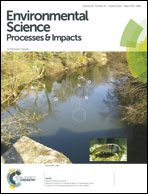Wastewater micropollutants as tracers of sewage contamination: analysis of combined sewer overflow and stream sediments†
Abstract
A sensitive method was developed to measure the sediment concentration of 10 wastewater micropollutants selected as potential sanitary tracers of sewage contamination and include: nonsteroidal anti-inflammatory drugs (acetaminophen – ACE and diclofenac – DIC), an anti-epileptic drug (carbamazepine – CBZ), a β-blocker (atenolol – ATL), a stimulant (caffeine – CAF), a bronchodilator (theophylline – THEO), steroid hormones (progesterone – PRO and medroxyprogesterone – MedP), an artificial sweetener (aspartame – APM) and personal care products (N,N-diethyl-3-methylbenzamide – DEET). Natural sediments (combined sewer overflow and stream sediments) were extracted by ultrasonic-assisted extraction followed by solid-phase extraction. Analyses were performed using ultra-high-performance liquid chromatography-tandem mass spectrometry (UHPLC-MS/MS) using atmospheric pressure chemical ionisation in positive mode (APCI+) with a total analysis time of 4.5 min. Method detection limits were in the range of 0.01 to 15 ng g−1 dry weight (dw) for the compounds of interest, with recoveries ranging from 75% to 156%. Matrix effects were observed for some compounds, never exceeding |±18%|. All results displayed a good degree of reproducibility and repeatability, with relative standard deviations (RSD) of less than 23% for all compounds. The method was applied to an investigation of stream and combined sewer overflow sediment samples that differed in organic carbon contents and particle size distributions. Acetaminophen, caffeine and theophylline (as confounded with paraxanthine) were ubiquitously detected at 0.13–22 ng g−1 dw in stream bed sediment samples and 98–427 ng g−1 dw in combined sewer overflow sediment samples. Atenolol (80.5 ng g−1 dw) and carbamazepine (54 ng g−1 dw) were quantified only in combined sewer overflow sediment samples. The highest concentrations were recorded for DEET (14 ng g−1 dw) and progesterone (11.5 ng g−1 dw) in stream bed and combined sewer overflow sediment samples, respectively. The ratio of concentration to its limit of detection (C : LOD) in sediments for a subset of compounds were compared to their C : LOD in water. In waters with a large capacity for dilution relative to fecal sources, the C : LOD ranges in sediments were greater than in water. Thus monitoring programs for fecal source tracking using wastewater micropollutants should consider sediment sampling, particularly for waters with highly diluted sources of fecal contamination.


 Please wait while we load your content...
Please wait while we load your content...